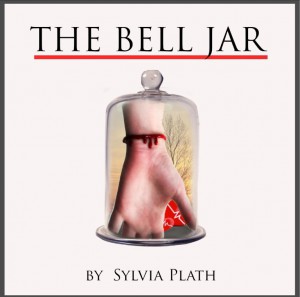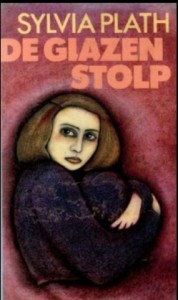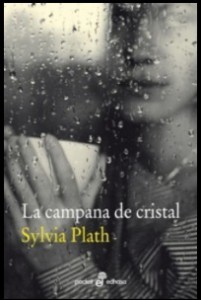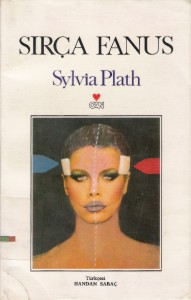http://youtu.be/MkRmnrei3FI
Category Archives: Sylvia Plath
The bell jar project two, part 2
PART TWO
The novel “The bell Jar” has been portrayed differently all around the world. For my cover I have chosen to represent the most symbolic symbols noted in the novel. These symbols include mirrors,fig tree, blood,and heartbeats. I choose my cover to represent these symbols because I believe these symbols depicts important moments in the novel. In the novel Esther worst enemy is herself,she knows that she wanted to kill herself but doesn’t have a logical reason as to why. As shown in the novel, Esther constantly confronts reflection on herself. After her shock treatment with Dr. Gordon she thinks her reflection is another women in the room and even more so after her last attempt to kill herself she couldn’t recognize herself in the mirror.
This moment is demonstrated in my cover in the reflection of the fig tree. The fig tree is also another important symbol in the novel. The fig tree is mentioned multiple times in the book. In Esther’s case, the fig tree represents a different life and she can only choose one. She struggles with the decision to make a choice. Esther’s inability to make a decision leads us to another symbol that is constantly used in the novel, which is blood. The shedding of blood marks transitions in Esther’s life. This includes when Marco tries to rape her and he smeared blood on her, when she loose her virginity she bleeds heavily, and when she decides to kill herself, she slashes her calf for preparation to slash her wrists. Esther slashing her wrist is shown vividly in my cover because this was the moment she first attempted to kill herself. The presence of blood shows that Esther will sacrifice her body for peace of mind.
Although she wanted to kill herself, she was unsuccessful in all attempts. Her failure to successfully kill herself is shown through another symbol of the novel, heartbeat. Her body was determined to live in all attempts. The beating heart symbolizes this bodily desire to live. In her attempt to drown herself, her heart beats ” I am I am I am.” The heartbeat is represented in my cover through the red heart by the hand. The mirror, fig tree, blood, and the heartbeat are very important aspects of the novel. I’ve tried my best to portray this idea in my cover by using four simple photos and combining them together to make one thing.
The bell jar covers
Spanish Edition. Dutch edition
Date:2005 Date: unknown
Esther greenwood is like most teenagers coming of age, young and ready to take over the world. In Esther’s case, she struggles greatly to be the normal women that society as portrait in the 1950’s. The Novel “The Bell Jar” by Sylvia Plath depicts the life of Esther Greenwood as she descent into and return from madness. Plath was descriptively committed in depicting Esther’s self absorption, confusion, and naïveté state as she struggles with society it self. The mood of the story is dark and gloomy. You can almost feel the confusion and lost state that Esther is facing.The setting of the Bell jar is set in the late 1900s. Most of the story takes place in the mental institution. Esther who is the protagonist of the story is confined to the mental institution. In there she feels depressed and irritable in her own skin. As a result of feeling this way, she delves into suicidual attempts, unresolved issues with her fathers death, her attempted rape with Marco, and her constant struggle with identity. The plot changes as Esther’s mental health improved. The mood of the story changes from dark to restoring.
The Bell Jar is a story many people can relate to. The/ ball jar covers have a rich history since the release of the story. Different publishes all around the world have created covers that portray their representation of the ball jar. The two covers I have chosen presents two different styles to illustrate takes on the classic Novel “The Bell Jar”. One represents a young women afraid to face the world and the other represents a women facing the world with all the storms and rain it comes with. Both covers exemplifies the aspects of Esther’s disturbed mind as she descends to madness.
The first cover that I choose is a 2005 Spanish edition.The cover presents a silhouette of a women photographed. The women is sitting next to a window that has a blurred out tree. The tree is at a distance, all is at view is a bright light. The light is penetrating on the right side of her face .The left side of the women’s face is darker than the right side. Her eyes are blurred out on one angle. At first glance you notice that the women is holding a mud with rain dripping down her face in a melancholic state. She has a mysterious look on her face with a slight smirk. On one side of her side you can see her eye, on the other side, her eye is blurred out, and the image is lighter on that side. This split between the two side evades aspects of Esther’s life.
The cover can be interpreted through many perspectives. Since depression and identity are major themes of this novel, they also take part in the cover as it shows how Esther descends to madness . The dark mood of the cover is a representation of Esther’s depressed state. She struggled greatly to balance what society expects and her own feelings.When Esther was in New York she had a hard time depicting who she really is and how she should behave. This comparison is shown through the black and white filter of the photographed cover. The color white in this stance represents the constantly cheerful and peppy girl that society wants and accepts. Esther feels that mankind has placed a set of rules that she can’t and will not abide by. For instance society expects her to remain a virgin until marriage but she embarks on loosing her virginity before marriage. Esther received a scholarship to go to New York for a month and work for a magazine company . Like most teenagers this should be a glorious time but Esther didn’t feel that way. As evidence shows in the story “I just bumped from hotel to work and to parties and from parties to my hotel and back to work like a numb trolley bus”. The dark contrast of the cover represents the uncertainty that Esther feels about her own abilities that later sends her to madness . She didn’t enjoy New York like the other girls as she states ” I guess I should have been excited the way most of the other girls were, but I couldn’t get myself to react. She felt “still and empty” and even dull, she had no control of her mind.
The cover can also reflect the moment Esther goes to Dr. Gordon’s hospital for her shock treatment;After not being able to sleep for seven nights or changed her clothes. The bright light of the cover penetrating from the window remains me of this scene. As Esther and her mother walked in the medical establishment they experience this same light as they describe as a “summer hotel.” (Plath, 141). When Doctor Gordon escorted Esther to her room that was “bare..at the back of house”, they saw windows that were blurred out (142). From the cover’s perspective you can see that the window is blurred out with extremely bright lights. The light in the cover symbolizes “each flash” and “great jolt” (143) that Esther felt during her shock treatment. After going through such a horrifying experience Esther sit in a chair holding “a small cocktail glass of tomato juice”. (143)
This moment is reenacted in the photographed cover of the women holding the mug with rain falling down her face. The rain shows the sadness Esther felt after her shock treatment, she didn’t feel any better as Dr. Gordon asked ” how do you feel? And she replied saying “All right, but I didn’t, I felt terrible”. (144)
The cover can also be connected to the fig tree that was mention in the Novel numerous times. In the cover, there is tree that is shown in the window at a blurred distance. This tree can be a representation of the fig tree comparison Esther mentions. In the story Esther reads about a man and a woman from two different religions who meet underneath a fig tree. She relates the fig tree to her relationship with Buddy and later thinks of the tree as her options in life . ” one fig was a husband and a happy home and children, and another fig was a famous poet..” (77). The fig tree symbolizes the life choices that Esther faces. She pictures each tree to represent a different life she would choose. She can’t make up her mind because she wanted it all, as she states ” I wanted each and every one of them, but choosing one meant losing all the rest.”(77) knowing this made Esther even more depressed, this exemplifies Esther’s mind as she goes insane.
The second cover that I choose is the Dutch edition.This cover shows a animated photo of a young lady who is Esther sitting down with her legs crawled to the side. She is sitting almost in fatal position. This symbolizes how anger Esther is at the world. She looks cold, lost scared and has no smile on her face. The women in the cover has on markup and dark eyeliner, which could represent Esther’s tired and unpleasant appearance after seven restless nights. The cover has a red background and Esther had on black clothing. This contrast represents how dark and dangerous Esther is to her own body and mind, the red represents all the demons she faces.
To face the demons in her mind that descends her to madness, Esther attempts to kill herself several times. This cover depicts Esther’s last attempt to end her life. Her first three attempts didn’t play out like she planed. She tried to slit her wrists but can only bring herself to slash her calf, She tries to hang herself, but cannot find a place to tie the rope in her low‑ceilinged house, “the trouble was, our house had the wrong kind of ceilings.” (158) At the beach with friends, she attempts to drown herself, but she keeps floating to the surface of the water. (160) For her last attempt she crawled in a basement tight space wrapped in a black coat as the cover presents. Cobwebs touched all over her face as she ” unscrewed the bottle of pills and started taking them swiftly.” (169) After taking a large quantity of the pills, she saw red and blue lights flashing in her eyes. The red lights in this moment can be a representation of the background in the image.
Another aspect of novel that relates to the cover is the moment Esther wanted to look into a mirror after attempting suicide. In the animated photo of the lady, the lady is wearing a large amount of makeup. The make up in the photo doesn’t depict this scene because Esther didn’t have make up on after taking a large amount of pills. But I do believe the make up represents Esther’s difficulty identifying herself. After her last attempt to kill take her life , she couldn’t recognize her own discolored face. She couldn’t even recognize her whole body as she states ” I look down at the yellow legs sticking out of the unfamiliar white silk pajamas they had dressed me in. The skin shook flabbily when I moved.”(172) She wanted to look into a mirror but the nurse advised her not to because she didn’t look very pretty (174) As she viewed herself in the mirror, the person she saw was not herself but a picture of someone self. She couldn’t tell whether the person in the mirror was a man or woman because the person had pale mouth, rose colored cheeks and as she described “the face was it supernatural conglomeration of bright colors.”(174) The irony of Esther in the cover wearing powder and other cosmetics portraits what Esther wants the world to view her as. She struggles greatly with identifying herself in society. The makeup she is wearing in the photo relates to Esther’s mind and how she descends to madness.
The two covers demonstrate a women that feels alone and empty.Esther felt disconnected from everything around her. She battled greatly with the world alone. In both covers it portraits a women that is mad at the world. Both women are sitting by themselves and everything else around them is not in focus. Even though they are both sitting alone, the background for each cover is different. In the Spanish edition, the background is dark with bright lights and in the Dutch edition the background is a dark red with tiny white shadings. The two covers shows how Esther felt isolated and lost, due to the dark mood of both covers.
In conclusion, both covers give the viewers two different takes on the novel. Even though both covers represent different aspects of the story, they both represent who Esther is as a women that sinks to madness. The ball jar is a novel, which as been illustrated through the eyes of many individuals throughout the world. With great artistry and great visual interpretations to create wonderful covers the Dutch edition and the Spanish edition of “The ball jar” exemplifies Esther’s inner and outer thoughts that drives her to insanity.
The Bell Jar
The Bell Jar Book Covers
PART 1
COVER 1
Publication date: 3/1/2013
Press published with: Faber and Faber
Location: United Kingdom
Any other identifiers: 50th Anniversary Edition
COVER 2
Turkish Cover
Publication date: 2009, 6th Edition
Press published with: Can Publishing
Location: Istanbul, Turkey
Translated by: Handan Sarac
The Bell Jar written by Sylvia Plath follows Esther Greenwood, the main character, who although is a striving young writer, finds herself spiraling downward into depression and eventually a suicide attempt.
There are many cover designs for the book that have appeared in many languages since 1963. The two covers I chose relates to many aspects of the novel. The 50th Anniversary Edition book cover published by Faber and Faber features a photograph of a young woman, powdering her face and looking into a mirrored make up compact. She does not look at the camera. We can see her face in profile and reflected back at us by the mirror.
I believe this book cover captures the essence of the protagonist’s dilemma perfectly. At the beginning of the book, The Bell Jar’s protagonist Esther Greenwood is working as a writer on a New York magazine; she and the other girls are given numerous freebies which include make up and lipsticks; they are living and working in an environment concerned with glamour and fashion. In the beginning of the story Esther says, “ I still have the makeup kit they game, fitted out for a person with brown eyes and brown hair, an oblong of brown mascara with a tiny brush, a round basin of blue eye-shadow just big enough to dab the tip of your finger in, and three lipsticks ranging from red to pink, all cased in the same little gilt box with a mirror on one side. I also have a white plastic sunglasses case with colored shells and sequins and a green plastic starfish sewed onto it.” Her reminiscing about the makeup kit she got years ago lets us know that she survived the story she’s about to tell us. Even though this cover doesn’t really shows the dark side of Esther’s life, it may be suggesting that even a “normal” looking woman, putting on make-up and trying to look good can experience mental health problems.
This cover also relates to one of the symbols Plath used over and over through the novel. The mirror! One of Esther’s problems is that she does not really know who she is. She has no firm sense of identity. It is noticeable how often she looks into a mirror, or sees a reflection of herself but does not recognize the image as herself. It shows us how Esther is increasingly withdrawing from herself, with her failure to identify with her reflection in a mirror.
For example, in the reflection in the elevator in New York, she remarks; “I noticed a big, smudgy-eyed Chinese woman staring idiotically into my face.” (pg. 18). Then, on the train going home, she said; “the face in the mirror looked like a sick Indian.” (pg. 113). Also when she first looks in a mirror in the hospital, after her suicide attempt, she is so disfigured that she does not recognize herself saying “It wasn’t a mirror at all, but a picture.” Another quote from the novel where we can see how Esther is not able to identify herself with her reflection in the mirror is when she said, “I moved in front of the medicine cabinet. If I looked in the mirror while I did it, it would be like watching somebody else, in a book or a play. But the person in the mirror was paralyzed and too stupid to do a thing” (pg. 147-148). What these examples suggest is that Esther’s feelings of inadequacy lead her into a dislike of her own appearance and a feeling that she is not really being herself. This is because her failure to recognize her own reflection stands for the difficulty she has of understanding herself.
The Turkish book cover published by Can Publishing in 2009 “Sirca Fanus”, meaning “The Bell Jar” in Turkish, features a portrait of a glamorous woman wearing lots of make up with a dull and emotionless expression in her face. With very short hair, the lifeless stare in her eyes and shape of her head reminds of a human cadaver head. In connection with the novel, the image of the cadaver head occurs on the first page of the novel. Esther says “I kept hearing about the Rosenbergs over the radio and at the office until I couldn’t get them out of my mind. It was like the first time I saw a cadaver. For weeks afterward, the cadaver’s head–or what there was left of it–floated up behind my eggs and bacon at breakfast. I felt as though I was carrying that cadaver’s head around with me on a string, like some black, noseless balloon stinking of vinegar.” In another words, her inability to get a cadaver’s head out of her mind points out to death.
Furthermore, the woman on the second book cover looks stiff, immobile and inhumane looking, just like how she felt about the cadavers. She said; “These cadavers were so unhuman-looking. They didn’t bother me a bit. They had stiff, leathery, purple black skin and they smelt like old pickle jars.” (p. 63).
Later in the novel, Esther is put into a mental institution and is given electroshock therapy. On the cover of the Turkish translated version of the novel, we can notice two white bandages on the sides of her head above her ears. This takes us back to Esther’s first experience with Electroshock therapy. She says “Doctor Gordon was fitting two metal plates on either side of my head. He buckled them into place with a strap that dented my forehead, and gave me a wire to bite”. (pg. 143). This shows us how her first experience with Electroshock therapy was horrifying to her.
Both covers may be making reference to societal pressures of the time. In the 50s and early 60s women’s behavior was governed by certain social mores and they were valued mainly with regard to looks rather than ability. Both covers demonstrate a woman wearing lots of make up. We can suggest that make up covers imperfections and the way make up is used in these covers can tell us that how Esther is trying look on the outside; perfect skin and bright colors. Since the entire book deals with appearance and reality I believe Esther’s outward appearance belies what is happening within. Excessive use of make up for example shows us Esther’s struggle to cover-up her imperfections in her own life. Both covers represent how Esther always struggles to keep the outward self she presents to the world united with the inner self that she experiences.
Also, the women’s face on both covers almost wears a sneer. On the 50th Anniversary cover, the woman sneers at herself and is reflected right back at us and on the Turkish edition cover, an upside down frown is lightly drawn on the sides of the woman’s lips. Both the half reflected image from the mirror and the sneer can demonstrate Esther’s inability to unify herself and the splitting of her selves and Esther’s breakdown where she got admitted to a mental institution. In the first book cover, she seems more comfortable with herself, calmly fixing her makeup, almost like getting ready for a night out. However on the second book cover, her makeup is done in a way of applying makeup on a corpse for viewing, overly done.
PART 2
.
I chose the above image to design my book cover. I wanted to focus on the two reoccurring themes in the novel. First theme is the bell jar and for Esther the bell jar symbolizes madness. She feels as if she is inside an airless jar that distorts her perspective on the world and keeps her alienated.
Second reoccurring theme is the fig tree. Early in the novel, Esther reads a story about a Jewish man and a nun who meet under a fig tree. Their relationship is unfortunate just as she feels her relationship with Buddy is unfortunate. For Esther, Buddy Willard is a symbol of her deflated expectations. Later in the novel, the tree becomes a symbol of the life choices that face Esther. She imagines that each fig represents a different life. She can only choose one fig, but because she wants all of them, she sits paralyzed with indecision and the figs fall to the ground. She says: “I saw myself sitting in the crotch of this fig tree, starving to death, just because I couldn’t make up my mind which of the figs I would choose. I wanted each and every one of them, but choosing one meant losing all the rest, and, as I sat there, unable to decide, the figs began to wrinkle and go black, and, one by one, they plopped to the ground at my feet.”(77). Her problem is that she has too many options, but no satisfying option that can conform to what is traditionally expected of her. Furthermore, Esther’s inability to make decisions about her future has to do with her negative perception of self and her belief that she is unqualified to make such a decision.
In the above image, the sapling (young fig tree) in the bell jar represents Esther who is still yet to grow and have all the expectations a young woman has. The sapling is trapped inside the bell jar, just like Esther feels. As the sapling grows, the bell jar will be too small for it. As it grows it needs bigger space, more soil, more water and nourishment. If the sampling stays trapped inside the bell it will not grow and eventually die. This can be a symbol of Esther being imprisoned within her own mind. Even her choices and her thoughts are stuck inside the bell jar because figs symbolized her choices and a sampling can’t produce figs unless it grows.
If you look closely the bell jar is almost in the shape of a woman’s shadow. Her head and shoulders are visible as if she is standing on top of the sampling. The darkness and the blur represent Esther’s mental breakdown and the way she sees her life through the bell jar.
Project #2
Project # 2 (Part 2)
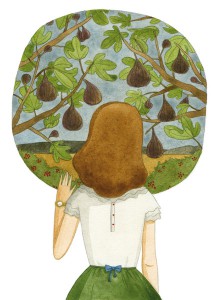
I used this image of a woman looking at a fig tree for my cover because the fig tree was brought up numerous times throughout the book to represent how Esther viewed her own life and the different branches it represents in it. At first it was mentioned in Chapter 5, when Esther connected with the story of the Jewish man and Nun meeting at the fig tree. She relates to her own experience with buddy. “It seemed to me Buddy Willard and I were like that Jewish man and that nun, although of course we weren’t Jewish or Catholic but Unitarian. We had met together under our own imaginary fig tree, and what we had seen wasn’t a bird coming out of an egg but a baby coming out of a woman, and then something awful happened and we went our separate ways.” (Plath, chapter 5) She connects the way the relationship between the Jewish man and the Nun is doomed after they’ve touched hands, the way hers and Buddy’s is doomed. Also, they’re very similar to the Jewish man and Nun due to their differing outlook on life, especially their gender differences.
In chapter 7, Esther mentions the fig tree once more when she is with Constantine and the Russian woman who can recite so many different idioms. She thinks about how inadequate she feels compared to these people and think about the many different ways her own life can branch out. “I saw myself sitting in the crotch of this fig tree, starving to death, just because I couldn’t make up my mind which of the figs I would choose. I wanted each and every one of them, but choosing one meant losing all the rest, and, as I sat there, unable to decide, the figs began to wrinkle and go black, and, one by one, they plopped to the ground at my feet.”(Plath, Chapter 7) She feels that because she is a woman, she has many more responsibilities and options that she can choose. She feels as though she can only choose one way and ends up feeling troubled and indecisive.
This image I chose shows a girl looking out at the tree and the different figs and to me it mainly connects back to Chapter 7 as Esther contemplates her own decisions in life and where she wants to go from there.She has many different possibilities to choose from but this is a great dilemma because she wants to do it all.
Project #2
Part 1

The first edition, 1963

Perennial Edition, 2000
The cover of a book has the power of making customers purchase something they normally wouldn’t, or it can make them ignore a title they probably would enjoy reading. As a prospect reader walks down the aisle of a bookstore, the cover of a book has normally very limited time to capture someone’s attention. In a sea of different color schemes, materials and shapes, a cover has to have that extra “something” to catch people’s attention. Many books succeed at being picked up by using bright colors and shiny paper, but fail at transmitting the real essence of the title.
Sylvia Plath’s “The Bell Jar” certainly isn’t a book that can easily be summarized with a cover. The novel portrays the journey of a young lady, Esther, who walks down a rather troubled path in her life. Throughout the story, she deals with different types of disillusion, which lead her to acute depression. At first, one may think she has everything going for her: she’s smart, funny; her professional life seems to be going well. As the story develops, it’s clear that Esther’s take on life is a rather tortured one. She doesn’t seem to be able to enjoy her achievements and can’t seem to relate to what is going on around her. Throughout the novel, Esther shares thoughts that support that idea, such as: “The trouble was, I had been inadequate all along, I simply hadn’t thought about it.” (Plath 70) That’s only one example of how the lack of empathy towards the world is a part of her life. She never seems to find a group she truly fits in and she hasn’t been able to acquire long-term friendships either.
“The Bell Jar” was first published in 1963 and, since then, it has featured over 30 different artworks for its cover; and the first edition published has a very interesting one. The cover is composed of a black and white picture of a woman sitting at a desk in what seems to be a bedroom or a home office, as the background. From what can be seen from a lateral view, she rests her elbow on the desk and her hand on the chin. On the foreground, it is possible to see a bell jar, which gives the impression that the woman could be in it. The glass distorts the image of the woman behind it, and it makes her figure look a bit warped. The idea of a bell jar, also present in the title of the novel, is a reference to an analogy that Esther uses several times to describe her feelings: “I would be sitting under the same glass bell jar, stewing in my own sour air.”(185) This “bell jar” symbolizes her struggles in life, which always suffocate her in low self-esteem form and it makes her never feel satisfied with what she achieves. That’s clear when she says, “I was supposed to be having the time of my life.”(2) She acknowledges that she should be happy, but she’s unable to properly feel that way.
In this first edition’s cover it is only possible to see her dark silhouette against a well-lit background, which gives the artwork a sinister feel and supports the subject of the novel. Alongside the dark colors of the photograph, the typography follows that same imagery. Both title of the book and name of the author (“Victoria Lucas”, Plath’s penname) are portrayed in a shade of purple. The title of the book appears with a large point-size, all caps and centered at the bottom; and it takes up almost the entire bottom half of the cover. The other typographic addition is the name of the author, up top, with the same purple, but written in cursive typeface, giving it a more delicate motif. The typographic choices add up to the dramatic atmosphere that the story inspires.
Another cover that succeeds at capturing the essence of “The Bell Jar” is the “Perennial Classics” version, from 2000. It also features a woman in a black and white photograph. This time, the woman is outdoors in what seems to be a backyard. She is wearing a white dress, against a dark background formed by trees. That brings up an element that played an important role in the novel: the fig tree reference.
“I saw my life branching out before me like the green fig tree in the story. From the tip of every branch, like a fat purple fig, a wonderful future beckoned and winked. One fig was a husband and a happy home and children, and another fig was a famous poet and another fig was a brilliant professor, and another fig was Ee Gee, the amazing editor, and another fig was Europe and Africa and South America, and another fig was Constantin and Socrates and Attila and a pack of other lovers with queer names and offbeat professions, and another fig was an Olympic lady crew champion, and beyond and above these figs were many more figs I couldn’t quite make out. I saw myself sitting in the crotch of this fig tree, starving to death, just because I couldn’t make up my mind which of the figs I would choose. I wanted each and every one of them, but choosing one meant losing all the rest, and, as I sat there, unable to decide, the figs began to wrinkle and go black, and, one by one, they plopped to the ground at my feet.”(77)
That is a very important, since it touches a major issue for Esther—the lack of assuredness in her life. She is an intelligent woman who would easily be able to follow a successful career path based on her academic records, but isn’t able to do so due to insecurities and, again, the lack of self-esteem. This “Perennial Classics” cover speaks to that as it has the face of the woman blurred out, as a way of conveying lack of identity, something Esther deals with. She can’t decide what she wants for her future and isn’t able to make crucial life decisions, which frustrates her even further.
This artwork also features purple typeface for the title of the book, but it’s in a lighter tone compared to the first edition, which makes it look more girly and adds to the innocent feel that the white—and somewhat short—dress also suggests. The name of the author (this time her real one) is written in white lower-case letters; also suggesting a soothing and young theme.
The fact that the woman appears in the back of the photo, reading as some distance from the foreground, and the way she’s pictured alone, play with the concept of solitude and indecisiveness once again. Here’s a quote from the novel that supports that thought: “The same thing happened over and over: I would catch sight of some flawless man in the distance, but as soon as he moved closer I immediately saw he wouldn’t do at all.”(83) Just like in this quote, the woman in the picture looks almost lost, looking for something or someone; but at the same time she doesn’t look like she’s about to go anywhere. Esther feels that way in many different moments, such as in this following one: “When they asked me what I wanted to be I said I didn’t know.”(101) She didn’t even know who she was, or what she wanted to be—let alone which direction she wanted her life to take; and this version of the book cover dialogs with that idea.
Both covers here discussed—the first edition and the “Perennial Classics” version—do a great job conveying the main points of the novel. The first one dabbles more deeply with the gloomy aspect of depression, by portraying the woman in a distorted way and in dark colors. This cover also features a more obvious reference to the bell jar, having the actual object as part of the artwork. The “Perennial Classics” cover is subtler in its references, leaving more to be further analyzed. This latter one focuses more on the lack of self-identity Esther struggled with throughout the novel—hence the woman’s blurred face, just standing still in a garden. The imagery of this cover is a more youthful one, as it brings up the notion of Esther’s unpreparedness to deal with life’s challenges.
It’s hard to decide which one has more efficient results. The two covers have similarities: both have black and white photographs, feature a woman, have purple typography, and play with light/dark. It’s interesting to see that they were made 37 years apart and yet have a lot in common. It’s left to be wondered of the first edition had its cover design authorized by the author, since she was still alive when it was published. It summarizes the idea of the novel very well, and so does the “Perennial Classics” version.
Not all of the various cover designs for “The Bell Jar” had such positive outcomes. Many missed the point in portraying the Esther Greenwood’s gloomy personality and her hardships in life. It’s hard to imagine how an artwork featuring bright colors and festive typography can be faithful to a story that narrates the experiences of a woman dealing with depression. With a few exceptions, almost all cover options have, rightfully, dimmed colors and a serious approach.
As mentioned before, “The Bell Jar” isn’t an easy novel to be translated into a book cover, but the two ones here analyzed perform the job really well. Whoever sees these artworks are able to at least have an idea of what the novel is about, and that’s exactly what you want from a book cover.
Part 2
For the creation of my own cover, I used two major references in the novel: the bell jar and the fig tree metaphors. The first one appears in various moments of the story and it symbolizes Esther’s fears, frustrations and pain. She feels trapped inside this bell jar that keeps her from enjoying life. “To the person in the bell jar, blank and stopped as a dead baby, the world itself is a bad dream.”(237) She is talking about herself, who suffers from depression and can’t seem to be able to enjoy life.
The other reference, with the figs, is an allusion to the many different goals she wants to achieve, but doesn’t think she will. She says: “I saw myself sitting in the crotch of this fig tree, starving to death, just because I couldn’t make up my mind which of the figs I would choose. I wanted each and every one of them, but choosing one meant losing all the rest, and, as I sat there, unable to decide, the figs began to wrinkle and go black, and, one by one, they plopped to the ground at my feet.”(77) Esther has so many possible ways to succeed in life, and yet she’s overwhelmed and can’t follow any plan in depth.
The cover was put together with the thought of having the figs trapped inside the bell jar, representing two main ideas:
– The figs, or her dreams, were there within reachable distance and she could get them if she wanted, but something was keeping her from doing so: depression.
– Her goals, or her expectations in life, were also suffocating her, just like the bell jar.
I went with that typographic choice because it’s delicate and dark, just like Esther’s mind. I distorted the figs to give them the same gloomy feel Esther describes in the story. I made them look darker so it seems like they’re going bad and Esther is running out of time to eat them, translating into the nerve-wrecking scenario she’s living in.
Blogging for Tuesday: Commenting on covers
Featured
Now that Project #2 posts are starting to appear, offer your classmates some feedback on their book-cover or image creations. Choose one and reply with a comment, approximately 150 words, even if you haven’t finished your own project! Reviewing what your classmates have achieved might help you finish yours if you haven’t already.
It would be great if when you post, even if you’re linking a file for the written work, to include the image for Part 2 in your post, so that it’s easy to see. It can entice us to click your link to read more about your cover.
As you complete Project #2, I’m sure you’re eagerly reading the excellent stories selected for this week. They’re in two pairs, and I’ll post a homework assignment soon for you to complete for Thursday. We’re moving into our most contemporary literature–enjoy!

